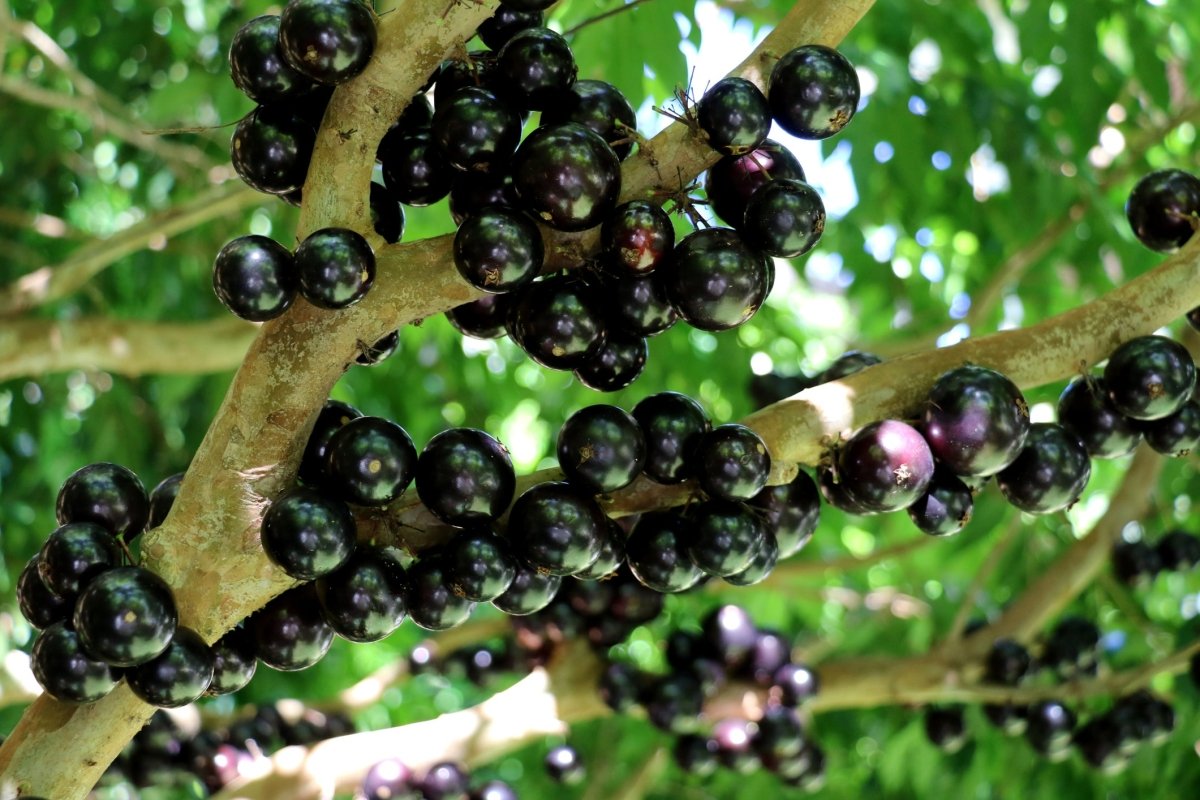Jabuticaba in Costa Rica: An Exotic Fruit Discovered
May 10 2024 – Michael Lindeman


Jabuticaba, an exotic fruit that has found an ideal home in the fertile lands of Costa Rica, is known for its distinctive flavor and multiple culinary and medicinal uses. This article explores the introduction of jabuticaba in Costa Rica, its cultivation, its culinary uses and health benefits.
The History of Jabuticaba

Jabuticaba (Plinia cauliflora) is a truly unique fruit whose origins can be traced back to the lush rainforests of Brazil. This peculiar deep purple berry grows directly from the trunk and thick branches of the tree, a unique feature in the plant kingdom. The first records of jabuticaba date back to pre-Columbian times, when the indigenous peoples of the region already consumed it and appreciated its nutritional and medicinal properties. In fact, its name comes from the Tupi-Guarani "ya-bu'ti-caba", which means "crushed fruit" referring to its irregular shape. With the Portuguese colonization, jabuticaba became known in other regions of Brazil and later spread to neighboring countries with similar tropical climates. Today, this exotic fruit is still cultivated mainly in its place of origin, the Brazilian Atlantic jungles and forests, although it is gaining more and more followers in various parts of the world.
Jabuticaba cultivation in Costa Rica

The introduction of jabuticaba to Costa Rica is a fascinating example of how exotic fruits can be integrated into new environments. Initially brought by Brazilian immigrants, jabuticaba found the ideal environment to thrive in the humid and fertile climate of Costa Rica.
Jabuticaba has adapted exceptionally well to the humid tropical climate of Costa Rica. Despite not being a well-known fruit in the country, its cultivation is gaining popularity among Costa Rican farmers due to its unique and exquisite flavor, as well as its numerous nutritional benefits. Today, it is cultivated mainly in areas such as Alajuela and Puntarenas, where small and medium producers explore its cultivation as a promising economic alternative. With proper management, these trees can produce abundant crops of juicy, sweet fruits for much of the year in the fertile Costa Rican lands.
The Flavor, Aroma and Appearance of Jabuticaba Fruit

Jabuticaba is a fruit that captivates the senses with its exquisite flavor, intoxicating aroma and peculiar appearance. When you bite into it, the white, juicy pulp explodes in your mouth with a sweet nectar of fruity notes and a slight touch of red wine. Its texture is soft and slightly crunchy, which makes it extremely refreshing. The aroma of jabuticaba is intense and captivating, with hints of ripe red fruits and sweet spices. As for their appearance, it's hard not to be fascinated by these deep, dark purple spheres that sprout directly from the trunk and thick branches of the tree. Its thick skin encases a juicy white pulp that comes off easily when you bite into the fruit. Without a doubt, jabuticaba is a unique sensory experience that makes you fall in love with its peculiar beauty, unmatched fragrance and delightful flavor.
Culinary Uses of Jabuticaba

Jabuticaba is a versatile and delicious fruit that can be used in multiple ways in the kitchen. One of the most popular ways to enjoy it is to eat it fresh, directly from the tree, where its dark skin encloses a white, juicy and extremely sweet pulp. However, this exotic fruit also lends itself to various culinary preparations. It can be used to make jams, jellies and preserves, ideal for spreading on bread or filling desserts. In addition, jabuticaba is a star ingredient in the production of juices and smoothies, thanks to its intense flavor and color. In savory cuisine, its juicy pulp can enhance sauces, vinaigrettes, and accompaniments for meats and fish.
Wines and Spirits Made with Jabuticaba

Jabuticaba, with its intense and sweet flavor, as well as its beautiful dark reddish color, is the perfect fruit for making exquisite artisanal wines and liquors. In Brazil, where this fruit is native, there is a long tradition of producing jabuticaba wines that delight the most demanding palates. The winemaking process captures the essence of the fruit, revealing fruity, spicy notes with a touch of vanilla. These red wines are characterized by their deep ruby color and pleasant acidity. On the other hand, jabuticaba liqueurs are a true delight, with their intoxicating aroma and soft velvety texture. They are obtained by macerating the fruit in alcohol, sometimes with the addition of spices such as cinnamon or cloves. These liqueurs are the perfect complement to desserts or simply to enjoy after a good meal.
Meads and Beers with Jabuticaba Made by Costa Rica Meadery

At Costa Rica Meadery, the exotic jabuticaba becomes the star of some of its most notable craft drinks. EXE is a dry honey wine enhanced with the intense fruity flavors and ruby color of this tropical fruit. On the other hand, MELINIA is a sweet honey wine where the sweet notes of jabuticaba blend deliciously with honey. For bubble lovers, PLINIA is a sparkling hydromel that captures the essence of jabuticaba in every effervescent sip. But if what you are looking for is something truly unique, CREPÚSCULO is a wild ale with a touch of jabuticaba that gives it an unmatched fruity and spicy character. All of these artisanal delights allow you to enjoy jabuticaba in new and innovative ways.
Health Benefits of Jabuticaba
Jabuticaba is much more than an exotic and delicious fruit, it is also a true superfood full of beneficial compounds for health. Rich in antioxidants such as flavonoids and anthocyanins, it helps fight oxidative stress and chronic inflammation in the body. Recent studies have shown that regular consumption of jabuticaba can help reduce bad cholesterol and triglyceride levels, while increasing good cholesterol, thus supporting cardiovascular health. Additionally, this fruit contains significant amounts of fiber, vitamins C and B, as well as essential minerals such as potassium and magnesium. Its anti-inflammatory and antioxidant properties also make it an ally against degenerative diseases such as Alzheimer's and Parkinson's. Without a doubt, incorporating jabuticaba into a balanced diet is an excellent way to enjoy its nutritional and medicinal qualities.
Frequently Asked Questions about Jabuticaba in Costa Rica
Where to Buy Jabuticaba in Costa Rica

During the harvest season, which generally runs from April to May, the Costa Rica Meadery company sells 1 kilo bags of fresh and ripe jabuticabas, ready to be enjoyed. These bags allow you to taste this delicacy directly from the tree without having to grow it. The increasing availability of jabuticaba in Costa Rica opens up a world of culinary possibilities with this unique and little-known fruit.
CONTACT US ABOUT AVAILABILITY:
VENTAS@COSTARICAMEADERY.COM
+506 2269-8166

Although jabuticaba is not a native fruit of Costa Rica, it is becoming easier to find it in the country. For those interested in growing their own jabuticaba trees, the nursery at El Arca Jardín Botánico offers young plants ready to be transplanted. With proper care, these fruit trees will begin to produce their coveted fruits within a few years.
Tips for Consumption and Conservation
When purchasing fresh jabuticabas, it is important to select those that have smooth skin, without dents or stains. Ripe fruits will be a deep purple, almost black color. To preserve them, it is best to store them in the refrigerator in a paper bag or a ventilated container. This way they will stay fresh for up to a week. Before eating, wash them well under running water to remove any residue. To fully enjoy their nutritional properties, eat them with the skin, as it contains high amounts of antioxidants and fiber. If you want to use them in culinary preparations, remove the skin and central seed. Ripe but firm jabuticabas are ideal for jams, while very soft ones work best for smoothies or juices. With these simple tips, you can make the most of the flavor and benefits of this exquisite tropical fruit.


0 comments